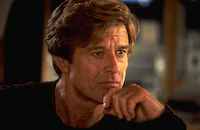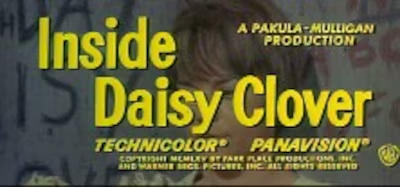Inside Daisy Clover

Brief Synopsis
Cast & Crew
Robert Mulligan
Natalie Wood
Christopher Plummer
Robert Redford
Roddy Mcdowall
Ruth Gordon
Film Details
Technical Specs

Synopsis
In California in 1936, Daisy Clover, a rebellious 15-year-old, lives with her mother whom she calls "The Dealer" because of her passion for playing solitaire. Daisy, who likes to sing, makes a recording of her voice and sends it to Hollywood studio head Raymond Swan, who gives Daisy a screen test and then a contract. Daisy's sister, Gloria, connives with her husband and Swan to have "The Dealer" committed to a sanitarium and herself appointed Daisy's guardian. At Swan's party to introduce Daisy to Hollywood, she meets screen idol Wade Lewis and then spends the night with him; and she does so again after the premiere of her film. When Daisy and Wade are summoned to Swan's office to explain their behavior, Wade announces his intention to marry Daisy. They wed, but when Daisy awakens on the first morning of their honeymoon, Wade is gone. She returns to Hollywood, where Melora, Swan's wife, tells Daisy that Wade prefers men to women. Heartbroken, Daisy takes "The Dealer" out of the sanitarium and brings her to live with her at a beachhouse, but "The Dealer" dies shortly thereafter. Daisy, working on a film, has a breakdown at the studio. She becomes a recluse at her beachhouse, refusing to speak to anyone, and makes an abortive suicide attempt. She leaves the house, the gas still on and a flame under the coffee, and the house blows up as she walks down the beach. Daisy is a has-been at 17, but she has made up her mind to fight back.

Director

Robert Mulligan
Cast

Natalie Wood

Christopher Plummer

Robert Redford

Roddy Mcdowall

Ruth Gordon
Katharine Bard
Peter Helm
Betty Harford
John Hale
Harold Gould
Ottola Nesmith
Edna Holland
Crew
Russell Ashley
Maryce Bates
Gordon Bau
Jack Bear
Rose Brandi
Ed Butterworth
Robert Clatworthy
Robert Cooper
Jack Cunningham
Richard Doran
Ralph Gerling
Al Greenway
Isabel M. Halliburton
Edith Head
John Hoffman
George James Hopkins
Robert Irving
Howard Jeffrey
George Justin
Joseph E. Kenny
Gavin Lambert
Ann Landers
Charles Lang
Louis Mashmeyer
M. A. Merrick
George Nogle
Eugene O'brien
Alan J. Pakula
Pakula-mulligan
André Previn
André Previn
Dory Previn
Meta Rebner
Jean Burt Reilly
Herbert Ross
Aaron Stell
Dean Tavoularis
Bill Thomas
Mel Traxel
Jackie Ward
Lee Wilson

Photo Collections
Videos
Movie Clip



Trailer
Hosted Intro
Film Details
Technical Specs

Award Nominations
Best Art Direction
Best Costume Design
Best Costume Design
Best Supporting Actress
Articles
Inside Daisy Clover
Wood herself was a Hollywood rarity, a child star who seemed to have made the transition to adult stardom gracefully and effortlessly. But her apparently-ideal marriage to actor Robert Wagner had ended in scandal when she began an affair with Warren Beatty, her co-star in Splendor in the Grass (1961). That had also ended, and although Wood was a huge star, she did not have the lasting personal relationship she craved, just like the title character of Inside Daisy Clover. Wood loved Gavin Lambert's script for the film, which he adapted from his own novel. Lambert became a close friend of the actress during filming and recalled her saying, "at every key moment of Daisy's life, she's alone!" That insight, along with Wood's own experiences as a child star, added layers to her performance.
Unlike Wood, Robert Redford was a relative newcomer to Hollywood. Inside Daisy Clover was his third film. He had recently starred in a Broadway hit, Barefoot in the Park, and was being touted as the next big movie star. Redford's handlers warned him against taking the role of the homosexual Wade Lewis in Inside Daisy Clover. But it would be one of Redford's first important roles, and he wanted to do it. However, before he would accept the part, he insisted on a rewrite so that the character's sexuality would be less overt. And he played Wade Lewis as narcissistic, rather than sexually ambivalent. But to Redford's dismay, a scene was added after the principal shooting was completed that spelled out the character's sexual preference. Nevertheless, Redford's performance earned excellent reviews and won him a Golden Globe award as a "Star of the Future." Redford went on to make another film with Natalie Wood, This Property Is Condemned (1966).
Ruth Gordon, who played Daisy's mother, was primarily a stage actress and writer, and had not appeared in a film since Action in the North Atlantic (1943). However, Gordon was a good friend of Natalie Wood's, and the two women had always wanted to work together. Although studio head Jack Warner wanted a big movie name to play Daisy's mother, Wood fought for Gordon, and finally got her way. The performance won Gordon an Oscar nomination. Inside Daisy Clover was also nominated for art direction & costume design.
In spite of the strong performances and attention to period detail, Inside Daisy Clover was hurt, perhaps fatally, by having 21 minutes cut before release. As a result, it was criticized for having a split personality - was it a satire of the era it depicted, thanks to Lambert's clever script and deliciously campy production numbers (songs by Andre and Dory Previn, and choreography by future director Herbert Ross), or was it a melodrama? At the time, the film failed to find an audience. But over the years, Inside Daisy Clover has won a cult following. It contains one of Natalie Wood's most heartfelt performances, and one of Robert Redford's most nuanced ones, a milestone in his early career.
Director: Robert Mulligan
Producer: Alan J. Pakula
Screenplay: Gavin Lambert, based on his novel
Editor: Aaron Stell
Cinematography: Charles Lang
Costume Design: Bill Thomas, Edith Head
Art Direction: Dean Tavoularis; set decoration, George James Hopkins
Music: Andre Previn; lyrics, Dory Previn
Cast: Natalie Wood (Daisy Clover), Christopher Plummer (Raymond Swan), Robert Redford (Wade Lewis), Roddy McDowall (Walter Baines), Ruth Gordon (The Dealer), Katharine Bard (Melora Swan).
C-129m.
by Margarita Landazuri

Inside Daisy Clover
Quotes
Trivia
Daisy's beach house (which is blown up in the final scene)originally belonged to silent star 'Barbara LaMarr' .
Miscellaneous Notes
Released in United States 1982
Released in United States October 25, 1989
Released in United States on Video May 6, 1992
Released in United States Winter January 1, 1966
Re-released in United States on Video January 19, 1994
Shown at Greater Fort Lauderdale Film Festival (Tribute to Natalie Wood) October 25, 1989.
Released in United States 1982 (Shown at FILMEX: Los Angeles International Film Exposition (Natalie Wood: A Retrospective) March 16 - April 1, 1982.)
Released in United States Winter January 1, 1966
Re-released in United States on Video January 19, 1994
Released in United States on Video May 6, 1992
Released in United States October 25, 1989 (Shown at Greater Fort Lauderdale Film Festival (Tribute to Natalie Wood) October 25, 1989.)















